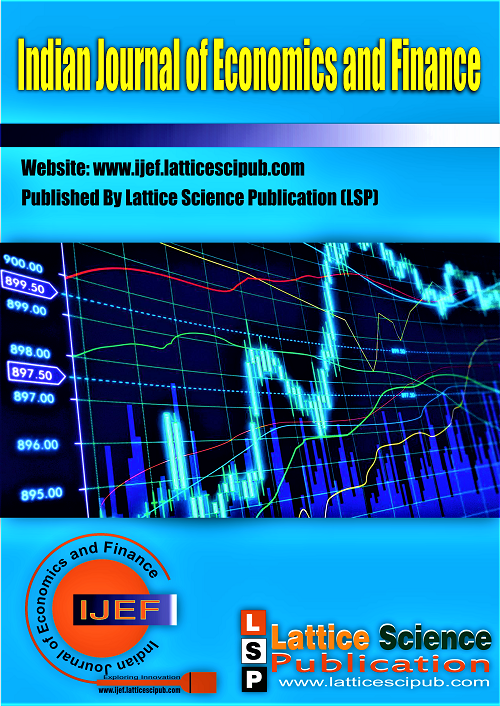Callable Bond Pricing using the Hull-White Model:A Comprehensive Analysis
Main Article Content
Abstract
This paper comprehensively analyses callable bond pricing using the Hull-White interest rate model. We compare the performance of the Hull-White model with other short-rate models, namely the Vasicek and Cox-Ingersoll-Ross (CIR) models, in pricing callable bonds across various market conditions. We demonstrate through extensive numerical simulations and empirical analysis that the Hull-White model generally outperforms other models in fitting the initial term structure and pricing callable bonds, particularly in volatile interest rate environments. We also propose an improved parameter estimation method for the Hull-White model, which enhances its pricing accuracy. Furthermore, we explore the implications of using the Hull-White model for callable bond pricing on issuer and investor behavior. Our findings contribute to the literature on interest rate modelling and provide practical guidelines for financial professionals in callable bonds’ valuation and risk management.
Downloads
Article Details

This work is licensed under a Creative Commons Attribution-NonCommercial-NoDerivatives 4.0 International License.
How to Cite
References
Aıt-Sahalia, Y. (1999). Transition densities for interest rate and other nonlinear diffusions. The Journal of Finance, 54(4), 1361–1395. doi. https://doi.org/10.1111/0022-1082.00149
Ametrano, F., & Ballabio, L. (2003). Quantlib: A free/open-source library for quantitative finance [Accessed: 2023-05-15]. doi. http://dx.doi.org/10.54946/wilm.11167
Andersen, L. B., & Piterbarg, V. V. (2010). Interest rate modeling (Vol. 3). Atlantic Financial Press. doi. https://doi.org/10.1007/s11408-011-0157-y
Babbs, S. H., & Nowman, K. B. (1999). Kalman filtering of generalized Vasicek term structure models. Journal of Financial and Quantitative Analysis, 34(1), 115–130. doi. https://doi.org/10.2307/2676248
Björk, T. (2009). Arbitrage theory in continuous time. Oxford University Press. doi. https://doi.org/10.1093/oso/9780198851615.001.0001
Bliss, R. R., & Ronn, E. I. (1989). Arbitrage-based estimation of nonstationary shifts in the term structure of interest rates. The Journal of Finance, 44(3), 591–610. doi. https://doi.org/10.2307/2328772
Brennan, M. J., & Schwartz, E. S. (1977). Savings bonds, retractable bonds, and callable bonds. Journal of Financial Economics, 5(1), 67–88. doi. https://doi.org/10.1016/0304-405X(77)90030-7
Brigo, D., & Mercurio, F. (2006). Interest rate models - theory and practice: With smile, inflation and credit. Springer Finance. doi. https://doi.org/10.1007/978-3-662-04553-4_9
Chan, K. C., Karolyi, G. A., Longstaff, F. A., & Sanders, A. B. (1992). An empirical comparison of alternative models of the short-term interest rate. The Journal of Finance, 47(3), 1209–1227. doi. https://doi.org/10.1111/j.1540-6261.1992.tb04011.x
Cox, J. C., Ingersoll Jr, J. E., & Ross, S. A. (1985). A theory of the term structure of interest rates. Econometrica, 53(2), 385–407. doi. https://doi.org/10.2307/1911242
Dick-Nielsen, J. (2009). Liquidity biases in TRACE. Journal of Fixed Income, 19(2), 43–55. doi. https://doi.org/10.3905/JFI.2009.19.2.043
Diebold, F. X., & Mariano, R. S. (1995). Comparing predictive accuracy. Journal of Business & Economic Statistics, 13(3), 253–263. doi. https://doi.org/10.1080/07350015.1995.10524599
Fleming, M. J., & Remolona, E. M. (1999). Price formation and liquidity in the U.S. treasury market: The response to public information. The Journal of Finance, 54(5), 1901–1915. doi. https://doi.org/10.1111/0022-1082.00172
Glasserman, P. (2003). Monte Carlo methods in financial engineering. Springer Science & Business Media. doi. https://doi.org/10.1007/978-0-387-21617-1
Gupta, A., & Subrahmanyam, M. G. (2000). An empirical examination of the convexity bias in the pricing of interest rate swaps. Journal of Financial Economics, 55(2), 239–279. doi. https://doi.org/10.1016/s0304-405x(99)00051-3
Gürkaynak, R. S., Sack, B., & Wright, J. H. (2007). The U.S. treasury yield curve: 1961 to the present. Journal of Monetary Economics, 54(8), 2291–2304. doi. https://doi.org/10.1016/j.jmoneco.2007.06.029
Hull, J., & White, A. (1990). Pricing interest-rate-derivative securities. The Review of Financial Studies, 3(4), 573–592. doi. https://doi.org/10.1093/rfs/3.4.573
Hull, J., & White, A. (1994). Numerical procedures for implementing term structure models i: Single-factor models. The Journal of Derivatives, 2(1), 7–16. doi.https://doi.org/10.3905/jod.1994.407902
Hull, J. C. (2017). Options, futures, and other derivatives (10th ed.). Pearson. doi. https://doi.org/10.2307/2328826
Kalotay, A. J., Williams, G. O., & Fabozzi, F. J. (1993). A model for valuing bonds and embedded options. Financial Analysts Journal, 49(3), 35–46. doi. https://doi.org/10.2469/faj.v49.n3.35
Lamberton, D., & Lapeyre, B. (2007). Introduction to stochastic calculus applied to finance (2nd ed.). Chapman; Hall/CRC. doi. https://doi.org/10.1201/9781420009941
Longstaff, F. A. (1992). Multiple equilibria and term structure models. Journal of Financial Economics, 32(3), 333–344. doi. https://doi.org/10.1016/0304-405x(92)90031-r
Ruijter, M. J., & Oosterlee, C. W. (2012). Two-Dimensional Fourier Cosine Series Expansion Method for Pricing Financial Options. SIAM Journal on Scientific Computing, 34(5), B642–B671. doi. https://doi.org/10.1137/120862053
Rebonato, R. (2004). Volatility and correlation: The perfect hedger and the fox (2nd ed.). John Wiley & Sons. doi. https://doi.org/10.1002/9781118673539
K. Vidhya, S.B. Inayath Ahamed, The Relationship of Interest Rate, Exchange Rate, GDP and FDI with Respect to Chinese Economy. (2019). In International Journal of Innovative Technology and Exploring Engineering (Vol. 8, Issue 11S2, pp. 273–277). doi. https://doi.org/10.35940/ijitee.k1042.09811s219
Kanaparthi, V. K. (2024). Evaluating Financial Risk in the Transition from EONIA to ESTER: A TimeGAN Approach with Enhanced VaR Estimations. In International Journal of Innovative Science and Modern Engineering (Vol. 12, Issue 2, pp. 1–9). doi. https://doi.org/10.35940/ijisme.b1312.12020224
Pratama, A. A. P. (2019). Why Capital’s Effect Differs in Bank Size? In International Journal of Management and Humanities (Vol. 4, Issue 2, pp. 24–27). doi. https://doi.org/10.35940/ijmh.b0394.104219
Tun, N. N., Alrajawy, I. M. M., & Bhaumik, A. (2020). The Implications of Interest Rates on Private Saving with Reference to Myanmar. In International Journal of Recent Technology and Engineering (IJRTE) (Vol. 8, Issue 5, pp. 1486–1492). doi. https://doi.org/10.35940/ijrte.e5906.018520
Nayak, M. (2020). A Method for Effective IT Project Risk Management. In International Journal of Engineering and Advanced Technology (Vol. 9, Issue 3, pp. 3480–3484). doi. https://doi.org/10.35940/ijeat.c5629.029320





